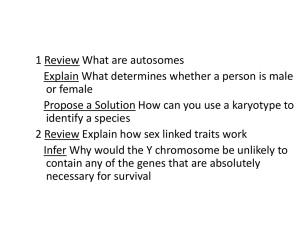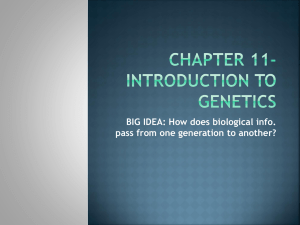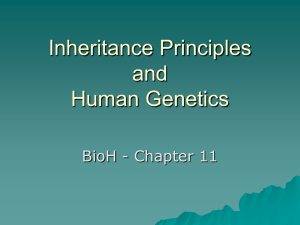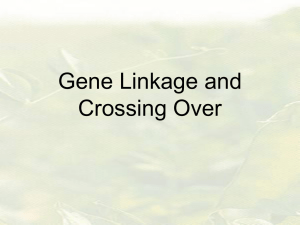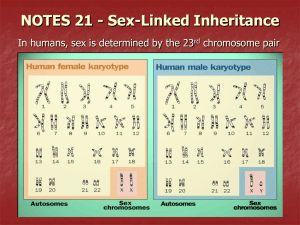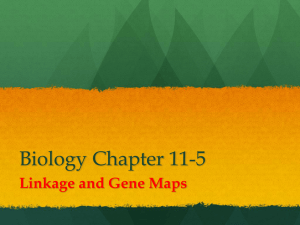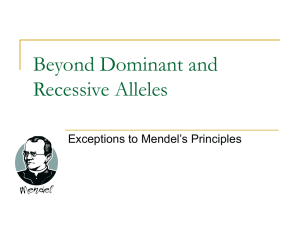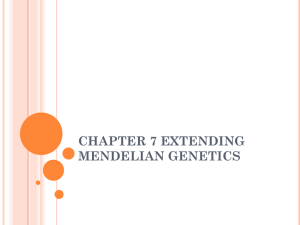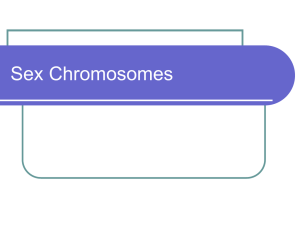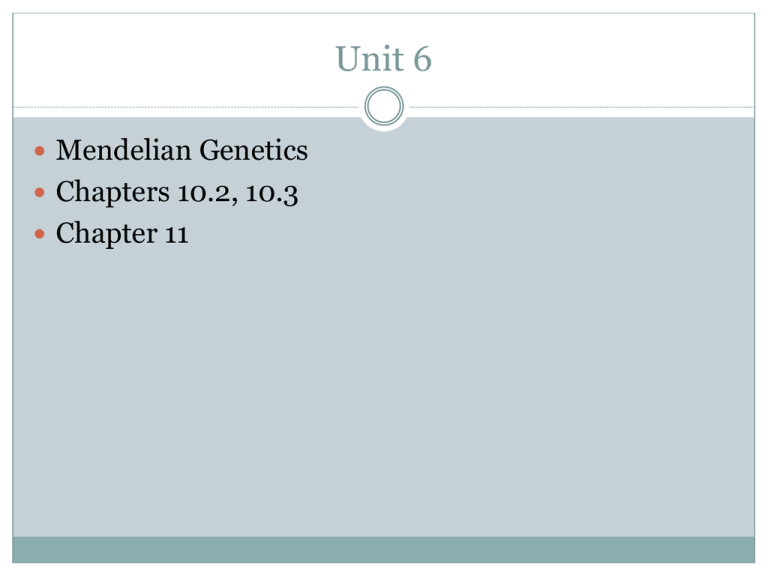
Unit 6
Mendelian Genetics
Chapters 10.2, 10.3
Chapter 11
Mendelian Genetics
Chapter 10.2
Explain
The significance of Mendel’s experiments to the
study of genetics
Summarize
The law of segregation and law of independent
assortment
Predict
The possible offspring from a cross using a Punnett
square
Mendelian Genetics
Mendel explained how a dominant allele can mask
the presence of a recessive allele
How Genetics Began
1866
How Genetics Began
1866
Gregor Mendel
How Genetics Began
1866
Gregor Mendel
Monk
How Genetics Began
1866
Gregor Mendel
Monk
Plant breeder
Pea plants
Easy to grow
Pea plants
Easy to grow
True-breeding
Pea plants
Easy to grow
True-breeding – consistently produce offspring with
only one form of a trait
Pea plants
Easy to grow
True-breeding – consistently produce offspring with
only one form of a trait
Self-fertilization
Genetics
The science of heredity
The Inheritance of traits
Mendel noticed
The Inheritance of traits
Mendel noticed
Certain traits
The Inheritance of traits
Mendel noticed
Certain traits
Generation after generation
Two true-breeding plants
P generation
Removed male organs
Cross pollinated
F1 Generation
Seeds grown from P
Alleles masked
Allowed to self
pollinate
F2 Generation
Offspring from F1
Masked trait reappears
Almost a perfect 3:1
ratio
Allele
Traits
Gene
Come in pairs
Dominant
Mendel’s term
Form of the trait that
appeared in the F1
Capital
Recessive
Mendel’s term
Form of the trait that
was masked in the F1
Lower case
Homozygous
Two of the same alleles for a particular trait
DD
nn
Heterozyous
Two different alleles for a particular trait
Dn
nD
Genotype
The organism’s allele pairs
Dn
nD
DD
nn
Phenotype
The observable characteristic
The outward expression of the allele pair
Dn
nD nn DD -
D
D
n
D
Law of segregation
Two alleles for each trait separate during meiosis
During fertilization, two alleles unite
Monohybrid cross
Cross that involves hybrids for a single trait
Dihybrid cross
Cross of plants with two or more traits
Dihybrid
Heterozygous for both traits
Law of independent assortment
Random distribution of alleles occurs during gamete
formation
Genes on separate chromosomes sort independently
during meiosis
9:3:3:1
Punnett Squares
Monohybrid cross
Take the different types
of alleles from each
parent
Place in the square
Dihybrid cross
9:3:3:1
F1 generation is crossed
Four types of alleles
from the male gametes
Four types of alleles
from the female
gametes
Probability
A coin landing on heads – ½
A coin landing on heads a second time – ¼
Mendel’s results were not perfect
Larger the number of offspring the closer
9:3:3:1
Gene Linkage and Polyploidy
Chapter 10.3
Main Idea
The crossing over of
linked genes is a source
of genetic variation
Genetic Recombination
The new combination of genes produced by crossing
over and independent assortment
Genetic Recombination
Genetic variation
Independent assortment
2n
where n is the number of chromosome pairs
Example
Pea plants have seven pairs of chromosome
Example
Pea plants have seven pairs of chromosome
2n
Example
Pea plants have seven pairs of chromosome
2n
27= 128
The possible number of combinations after
fertilization is
128 X 128 = 16,384
Example
Humans have 23 pair of chromosome
After fertilization
223 X 223 = more than a trillion
Example
Humans have 23 pair of chromosome
After fertilization
223 X 223 = more than a trillion
This doesn’t include the amount of genetic
recombination produced by crossing over
Gene Linkage
Chromosomes contain multiple genes that code for
proteins
Gene Linkage
Chromosomes contain multiple genes that code for
proteins
Genes located close to each other are said to be
linked and travel close together
Drosphila melanogaster
Fruit Fly
Gene linkage first studied
Genes usually travel together during meiosis
However, sometimes they don’t
Drosphila melanogaster
Fruit Fly
Gene linkage first studied
Genes usually travel together during meiosis
However, sometimes they don’t
Scientists concluded that linked genes can separate
during a crossover
Chromosome Maps
Chromosome Maps
First published in 1913
Chromosome Maps
First published in 1913
Fruit fly crosses
Chromosome Maps
First published in 1913
Fruit fly crosses
Not actual chromosome distances
Chromosome Maps
First published in 1913
Fruit fly crosses
Not actual chromosome distances
Represent relative positions of the genes
Chromosome Maps
First published in 1913
Fruit fly crosses
Not actual chromosome distances
Represent relative positions of the genes
Crossing over occurs more frequently between genes
that are far apart
In a cross
In a cross
Exchange of genes is directly related to the crossover
frequency
In a cross
Exchange of genes is directly related to the crossover
frequency
The frequency correlates with the relative distance
between the two genes
In a cross
Exchange of genes is directly related to the crossover
frequency
The frequency correlates with the relative distance
between the two genes
Genes that are further apart would have a greater
frequency of crossing over
Crossover
Polyploidy
One or more extra sets of all chromosomes in an
organism
Triploid organism
An organism with 3n chromosome
Three sets of chromosomes
Triploid organism
An organism with 3n chromosome
Three sets of chromosome
Rare
Triploid organism
An organism with 3n
chromosome
Three sets of
chromosome
Rare
Triploid organism
An organism with 3n
chromosome
Three sets of
chromosome
Rare
Lethal in humans
Triploid organism
An organism with 3n
chromosome
Three sets of
chromosome
Rare
Lethal in humans
Plants increase in vigor
and size
Mini Lab 10.2
MAP CHROMOSOMES
Where are genes located on a chromosome?
Where are genes located on a chromosome?
The distance between
two genes on a
chromosome is related to
the crossover frequency
between them.
Where are genes located on a chromosome?
The distance between
two genes on a
chromosome is related to
the crossover frequency
between them.
By comparing data for
several gene pairs, a
gene’s relative location
can be determined.
Get a Piece of paper
Draw a line
Get a Piece of paper
Draw a line
Mark centimeters (1 – 20)
Get a Piece of paper
Draw a line
Mark centimeters (1 – 20)
Label a mark in the center “A”
Model
Gene Pair
Crossover Frequency
AB
3
AC
1
AD
4
BC
2
BD
7
CD
5
Lab
Gene Pair
Crossover
Gene Pair
Crossover
AB
5.5
BF
4.3
AC
6.4
CD
10.9
AD
4.5
CE
2.6
AE
9.0
CF
5.2
AF
1.2
DE
13.5
BC
0.9
DF
5.7
BD
10.0
EF
7.8
BE
3.5
DRAW
Suppose genes C and D are linked on one
chromosome
And genes c and d are linked on another
chromosome
Assuming that crossing over does not take place
sketch the daughter cells resulting from meiosis
Show the chromosomes and position of the genes
Human Inheritance
CHAPTER 11.1
Basic Patterns of Human
Inheritance
CHAPTER 11.1
California State Standard
3C STUDENTS KNOW HOW TO PREDICT THE
PROBABLE MODE OF INHERITANCE FROM A
PEDIGREE DIAGRAM SHOWING PHENOTYPES
Pedigree
DEFINE
Pedigree
Purebred
Pedigree
A diagram
Pedigree
A diagram
Of a family tree
showing the occurrence of heritable characters in
parents and offspring over multiple generations.
Human traits
Follow Mendelian patterns of inheritance
Geneticists
Scientists who study traits
Geneticists
Scientists who study traits
Analyze the traits of offspring in a family
Geneticists
Scientists who study traits
Analyze the traits of offspring in a family
Map them to determine where a trait comes from
Geneticists
Scientists who study traits
Analyze the traits of offspring in a family
Map them to determine where a trait comes from
Collecting data from family with a trait that can be
traced
Geneticists
Scientists who study traits
Analyze the traits of offspring in a family
Map them to determine where a trait comes from
Collecting data from a family with a trait that can be
traced
Geneticists
Scientists who study traits
Analyze the traits of offspring in a family
Map them to determine where a trait comes from
Collecting data from a family with a trait that can be
traced
The family Pedigree
To make a map
Need symbols
Male
Female
Start at the beginning
Mom and Dad
Dad and Mom
Dad and Mom
Dad and Mom
Dad and Mom
Offspring
Brothers and sisters
Imagine you are a geneticist
“My name is Scott. My great grandfather Walter had
hairy earlobes (HE), but great grandma Elsie did not.
Walter and Elsie had three children: Lola, Leo, and
Duane. Leo the oldest, has HEs, as does the middle
child, Lola; but the youngest child, Duane, does not.
Duane never married and has no children. Leo
married Bertie, and they have one daughter, Patty.
In Leo’s family he is the only one with HEs. Lola
married John, and they have two children: Carolina
and Luetta. John does not have HEs, but both of his
daughters do.”
Example 2
Parents of a child with severe sensorineural hearing
loss are referred to the genetics clinic. They indicate
that they have had three children, son, daughter and
another son. The father of these children has two
sisters both of whom have two sons. His parents are
both well. No-one in his family has ever had a child
with hearing loss before. The mother of the three
children has a brother who has one son and one
daughter. Her parents are also well and once again
there is no known history of severed hearing loss in
childhood.
Example 2
However, her maternal grandfather developed
moderate hearing loss in his sixties. On specific
questioning the mother recalls that her maternal
grandmother was the sister of her husband’s
paternal grandmother.
Draw a pedigree
Chapter 11.2
Complex Patterns of Inheritance
Objectives
Distinguish between various complex inheritance
patterns
Analyze sex-linked and sex-limited inheritance
patterns
Explain how the environment can influence the
phenotype of an organism
Dominance
Heterozygous for a trait
Dominant trait shows phenotype
Plant (Tt)
T = tall
Incomplete Dominance
Red snapdragons – (RR)
White snapdragons – (rr)
Pink snapdragons – (Rr)
Codominance
Complex inheritance pattern
Both alleles are expressed
Sickle-cell disease
Disease affects red blood
cells
Affects the ability to
transport oxygen
Change in hemoglobin,
protein
When heterozygous have
both normal and sicklecell live a normal life
Sickle-cell disease and malaria
Scientists have discovered
Distribution of malaria and sickle-cell overlap
Those with heterozygous sickle-cell are more
resistant to malaria
Multiple Alleles
Blood groups
ABO blood types
Multiple Allele
Color coat of rabbits
C
cch
ch
c
Epistasis
One allele hiding the effects of another allele
Labrador’s coat color is controlled by two sets of
alleles
The dominant allele E determines whether the fur
will have dark pigment
EEbb or Eebb – Chocolate brown
eebb, eeBb or eeBB – Yellow
Sex Determination
46 chromosomes – 23 pair
One pair determines gender
X and Y
The other 22 pair are autosomes
Dosage Compensation
Females have 22 pair and one pair of
X chromosomes
Males have 22 pair and one Y and one X
chromosomes
X chromosome carries genes necessary for the
development for both females and males
Y chromosome carries genes necessary for the
development for males
Dosage
Females get two doses of X
One of the chromosomes shuts off
X-inactivation
Barr bodies – inactive X chromosome
Sex-Linked Traits
Traits that are controlled by genes located on the X
chromosome
Female with recessive trait on X would express the
trait on the other X chromosome
Red-green color blindness
XB
Y
XB
XBXB
XBY
Xb
XBXb
XbY
Mother is carrier
Father is not color blind
Only a son
8% of males are
Environmental influences
Environment has an influence on phenotype
Heart disease, diet and exercise
Sunlight, rainfall and weather
Temperature with cats and
pigment on fur
Twins
Scientist study twins to determine the difference of
environment on an individual
Chromosomes & Human
Heredity
CHAPTER 11.3
Karyotype Studies
Scientists study the whole chromosome
Pairs of chromosomes are arranged in descending
order
Telomeres
Protective cap on the chromosome
Made of protein
Involved in cancer and aging
Nondisjunction
Cell division during which sister chromatids fail to
separate properly
Meiosis I
Meiosis II
Down syndrome
Extra chromosome on 21
Trisomy
Distinctive facial features
Mental disabilities
Short stature
Heart defects
Nondisjunction in sex chromosomes
GENOTYPE
XX
Female
XO
Turner’s Syndrome
XXX
Nearly normal Female
XY
Male
XXY
Klinefelter’s syndrome
XYY
Nearly normal Male
OY
Results in death
Fetal Testing
Amniocentesis – diagnosis of chromosome
abnormalities – infection, miscarriage, discomfort
Chorionic Villus sampling – Diagnosis of
chromosome abnormalities – miscarriage, infection,
limb defects
Fetal blood sampling – diagnosis of chromosome
abnormalities – risk of bleeding, infection, amniotic
fluid might leak, risk of fetal death

